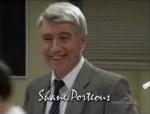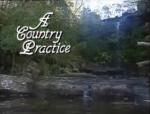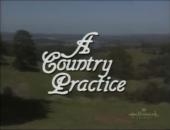AustLit
Latest Issues
AbstractHistoryArchive Description
Set in a small, fictional, New South Wales country town called Wandin Valley, A Country Practice focused on the staffs of the town's medical practice and local hospital and on the families of the doctors, nurses, and patients. Many of the episodes also featured guest characters (frequently patients served by the practice) through whom various social and medical problems were explored. Although often considered a soap opera, the series was not built around an open-ended narrative; instead, the two one-hour episodes screened per week formed a self-contained narrative block, though many of the storylines were developed as sub-plots for several episodes before becoming the focus of a particular week's storyline. While the focus was on topical issues such as youth unemployment, suicide, drug addiction, HIV/AIDS, and terminal illness, the program did sometimes explore culturally sensitive issues, including, for example, the Aboriginal community and their place in modern Australian society.
Among the show's principal characters were Dr Terence Elliott, local policeman Sergeant Frank Gilroy, Esme Watson, Shirley Dean Gilroy, Bob Hatfield, Vernon 'Cookie' Locke, and Matron Margaret 'Maggie' Sloan. In addition to its regularly rotating cast of characters, A Country Practice also had a cast of semi-regulars who would make appearances as the storylines permitted. Interestingly, while the series initially targeted the adult and older youth demographic, it became increasingly popular with children over the years.
Notes
-
One of the most popular drama series in Australian television history, A Country Practice ran on the Seven Network for 1,058 episodes from 18 November 1981 to 22 November 1993. It was produced in ATN-7's production facility at Epping, Sydney, with location shooting at Pitt Town (on the outskirts of Northwest Sydney). After Seven closed down production in 1993, Network 10 co-produced 30 additional episodes with JNP Films. This series, which aired between April and November 1994, was filmed largely on location in Emerald, Victoria.
-
The series was popular in a number of other countries, airing, for example, in the United Kingdom (through ITV), in several European countries, and in Hong Kong and Canada. It has been estimated that at its height, the show received a worldwide audience of five to six million each week.
-
Many well-known identities from outside television made guest appearances on the series over the years, including Baz Luhrmann, Smokey Dawson, John Meillon, Sir Robert Helpmann, Australian Prime Minister Bob Hawke, Nicole Kidman, Toni Collette, and Simon Baker. The series is also one of the most successful series in the history of the Logie Awards, having won twenty-nine times.
-
Further Reference:
- "A County Practice." Australian Television Information Archive - online (sighted 16/07/10).
- "A County Practice." Internet Movie Database - online (sighted 16/07/10)
- "A County Practice." TV.Com - online (sighted 16/07/10)
- Moran, Albert. Moran's Guide to Australian TV Series (1993), pp.130-132.
- Wandin Valley Bush Nursing Hospital: A Country Practice Fan Site - online (sighted 16/07/10).
-
Award-winning and individually published episodes of this series are included on AustLit.
Includes
-
4.11/4.12form y
 When the Bough Breaks
Sydney
:
JNP Films
,
1984
6072547
1984
single work
film/TV
When the Bough Breaks
Sydney
:
JNP Films
,
1984
6072547
1984
single work
film/TV
After Molly suffers a fall at the farm, her and Brendan's son is born prematurely and dies a few days after birth.
Sydney : JNP Films , 1984 -
5.38form y
 Lest We Forget : Part Two
Sydney
:
JNP Films
,
1985
6072710
1985
single work
film/TV
Lest We Forget : Part Two
Sydney
:
JNP Films
,
1985
6072710
1985
single work
film/TV
'Matron Sloan takes a special interest in a stranger who applies for a job at the hospital. Fatso is missing and Simon and Vicky are terrified when they hear that a wombat has been shot. Simon gets some unexpected training for the sleepless nights he can expect with the baby. Matron Sloan tries to help a Vietnam veteran who is suffering a breakdown.'
Source: Australian Television Information Archive. (Sighted: 20/6/2013)
Sydney : JNP Films , 1985 -
7.88form y
 Licensed to Kill : Part Four
Sydney
:
JNP Films
,
1987
6072805
1987
single work
film/TV
Licensed to Kill : Part Four
Sydney
:
JNP Films
,
1987
6072805
1987
single work
film/TV
'Wandin Valley is invaded by gun-toting hunters as the annual duck-season gets under way. Cathy is determined to find out who shot her horse. Jo refuses to talk to Michael despite his profuse apologies. Cathy decides to resign. Matron Sloan is intrigued to know why her two doctors are being so formal with each other. A shooting accident tears a family apart. Penny tries a little match-making between her two favourite doctors, although Terence and Alex don't seem to need much encouragement. Cathy tears up her resignation.'
Source: Australian Television Information Archive. (Sighted: 20/6/2013)
Sydney : JNP Films , 1987 -
8.72form y
 The Damage Done : Part Two
Sydney
:
JNP Films
,
1988
6072924
1988
single work
film/TV
The Damage Done : Part Two
Sydney
:
JNP Films
,
1988
6072924
1988
single work
film/TV
'A boy turns to his father for help when he is tormented by a fellow student. The hospital chef decides to propose to the girl of his dreams, but wakes up the next morning to find he has popped the question to someone entirely different. A terrified boy takes desperate measures to stop a bully. There are a few surprises for Jo on her eighteenth birthday.'
Source: Australian Television Information Archive. (Sighted: 20/6/2013)
Sydney : JNP Films , 1988 -
9.70form y
 Bel Canto : Part Two
Sydney
:
JNP Films
,
1989
6073051
1989
single work
film/TV
Bel Canto : Part Two
Sydney
:
JNP Films
,
1989
6073051
1989
single work
film/TV
'Victoria Flemming, a famous opera singer and her "maestro," Francesco Giannini, are befriended by Frank and Shirley. Cathy returns from Kakadu with a smile on her face. Could it have something to do with a mysterious helicopter pilot? Frank and Shirley's match-making pays off with the wedding of Victoria and Francesco. Lucy has big financial problems. With a bit of help from old Perce Hudson, Luke's precious car becomes a vet-mobile.'
Source: Australian Television Information Archive. (Sighted: 20/6/2013)
Sydney : JNP Films , 1989 -
10.36form y
 Confinement : Part Two
Sydney
:
JNP Films
,
1990
6073152
1990
single work
film/TV
Confinement : Part Two
Sydney
:
JNP Films
,
1990
6073152
1990
single work
film/TV
'Esme's use of steroids startles Wandin Valley residents. Steve's animals are being poisoned. John Bushnell, a mildly retarded man is abandoned at the hospital by his mother Sue and sister Alison. Jess and Cris help John overcome some of his difficulties. Terence and Ann form a new bond and relationship as they help Linda McNeil give birth. Matt has egg on his face when Bob and Cookie fall for his yarn about feral chooks.'
Source: Australian Television Information Archive. (Sighted: 20/6/2013)
Sydney : JNP Films , 1990 -
11.34form y
 Gift of Life : Part Two
Sydney
:
JNP Films
,
1991
6073262
1991
single work
film/TV
Gift of Life : Part Two
Sydney
:
JNP Films
,
1991
6073262
1991
single work
film/TV
'Lynette Cooper, a young and inexperienced farm hand, is left on her own to run the farm where she is working—until her long-lost sister shows up after having broken out of detention. Shirley has pneumonia. Harry tries to impress a young woman on the golf course. Steve has a close encounter with a horse on the highway.
'Harry decides that it would be best for him to move out of Steve's house and he finds a new home with Terence at Camelot. Rowie decides to donate one of her kidneys to save her sister. Tiger Kelly drives a truck into Cookie and Bob's house. Kate Bryant, a new nurse at the hospital, moves in with Steve and Luke at the farm and takes possession of the horse Steve nearly hit.'
Source: Australian Television Information Archive. (Sighted: 20/6/2013)
Sydney : JNP Films , 1991 -
13.46form y
 Another Country : Part Two
Sydney
:
JNP Films
,
1993
6075567
1993
single work
film/TV
Another Country : Part Two
Sydney
:
JNP Films
,
1993
6075567
1993
single work
film/TV
'Maryam Zahedi, an immigrant woman originally from the Middle East, loses her job at the hospital. She and her daughter Zozan are getting a rough time from people in the community, and when Tom comes by to see them, Maryam's daughter runs away in fear of him, or more accurately, his uniform. A farmer leaves his barking dog with Anna when his neighbours start complaining but it doesn't take long for the incessant noise to get to Harry either. The dog it turns out, can only be soothed by the music the farmer's recently deceased wife used to play. Maryam's application for residency is rejected. The new clinic receptionist is fired for smoking on the job.
'Hugo finds Zozan hiding out at at the lodge and takes her back to her mother. Bernice consults Harry, the resident golf expert, about putting in a golf course in at Rainbow Farm, while at the same time, Darcy is undertaking a plan to revegetate the land. Maryam receives notice that her husband has been executed. She is sent the bill for the bullet which provides the evidence she needs to claim refugee status. A party for Terence's 50th birthday is held at the club.'
Source: Australian Television Information Archive. (Sighted: 21/6/2013)
Sydney : JNP Films , 1993
Publication Details of Only Known VersionEarliest 2 Known Versions of
Works about this Work
-
Backwards to Bourke : Bulldust about Gays in the Bush
2022
single work
criticism
— Appears in: Journal of Australian Studies , vol. 46 no. 3 2022; (p. 307-320)'In his 2006 thesis, “‘Staying Bush’ – A Study of Gay Men Living in Rural Areas”, author Edward Green described his subject as the “largely hidden and untold story of gay men living in rural areas”. That was a pivotal year for gay men living in the bush, with Australian television broadcasters platforming two of their stories. In the space of one 12-month period, this cohort went from “hidden and untold” to prime time. From as early as 1989, rural politician Bob Katter had been declaring that he would “walk to Bourke backwards if the poof population of North Queensland is any more than 0.001 per cent”. Analysing media and popular culture, this article explores the visibility and portrayal of rural gay men in Australia prior to and after 2006. In spite of Katter’s minuscule population estimates, the rural gay cohort continues to defy assumptions.' (Publication abstract)
-
Ethnic Diversity within Australian Homes : Has Television Caught up to Social Reality?
2014
single work
criticism
— Appears in: Journal of Intercultural Studies , vol. 35 no. 1 2014; (p. 34-52) 'Inter-ethnic intimacy is on the rise in Australia, bringing an unprecedented level of ethnic diversity into our homes. Yet analyses of media representations of ethnic diversity have concentrated on the community level, neglecting the intimate sphere of family life. This paper explores the possibilities and limits of love within and across ethnic boundaries on fictional Australian television programmes. The results of a nine-week content analysis reveal a mixed picture. Inter-ethnic intimacy was regularly portrayed; but committed, long-term relationships across ethnic boundaries (marriage and co-habitation) were scarce. And although Australian television producers did not shy away from portraying physical intimacy across ethnic boundaries, emotional intimacy was often absent. Overt stereotyping of ethnic minority characters involved in inter-ethnic relationships was rare – instead, ethnic differences were downplayed or erased. Storylines were underpinned by the assimilation of inter-ethnic couples – in all their diversity – into the (white) mainstream.' (Publication abstract) -
The Emperor's New Clothes : The Logie Awards, Australian National Identity, TV and Popular Culture
2003
single work
criticism
— Appears in: Continuum : Journal of Media and Cultural Studies , vol. 17 no. 2 2003; (p. 119-134) -
y
 Australian Television : A Genealogy of Great Moments
South Melbourne
:
Oxford University Press
,
2001
10504917
2001
multi chapter work
criticism
Australian Television : A Genealogy of Great Moments
South Melbourne
:
Oxford University Press
,
2001
10504917
2001
multi chapter work
criticism
-
Searching for an Australian Identity
1999
single work
essay
— Appears in: Australian Screen Education Online , no. 22 1999; (p. 46-53) 'Investigations into the construction of Australianness are not new. From the 1970s, Australianness, embodied in the bronzed Anzac, has been criticised as reflecting only a limited masculine view, ignoring women, Aborigines and Australia’s multicultural society. Arguments about the validity of the characterisation were developed in response to Russell Ward’s thesis that the typical Australian need not be the average Australian, and that a valid construction of Australianness could be based on a legend which has its roots in pre-1851 Australia.'
-
The Emperor's New Clothes : The Logie Awards, Australian National Identity, TV and Popular Culture
2003
single work
criticism
— Appears in: Continuum : Journal of Media and Cultural Studies , vol. 17 no. 2 2003; (p. 119-134) -
Searching for an Australian Identity
1999
single work
essay
— Appears in: Australian Screen Education Online , no. 22 1999; (p. 46-53) 'Investigations into the construction of Australianness are not new. From the 1970s, Australianness, embodied in the bronzed Anzac, has been criticised as reflecting only a limited masculine view, ignoring women, Aborigines and Australia’s multicultural society. Arguments about the validity of the characterisation were developed in response to Russell Ward’s thesis that the typical Australian need not be the average Australian, and that a valid construction of Australianness could be based on a legend which has its roots in pre-1851 Australia.' -
Ethnic Diversity within Australian Homes : Has Television Caught up to Social Reality?
2014
single work
criticism
— Appears in: Journal of Intercultural Studies , vol. 35 no. 1 2014; (p. 34-52) 'Inter-ethnic intimacy is on the rise in Australia, bringing an unprecedented level of ethnic diversity into our homes. Yet analyses of media representations of ethnic diversity have concentrated on the community level, neglecting the intimate sphere of family life. This paper explores the possibilities and limits of love within and across ethnic boundaries on fictional Australian television programmes. The results of a nine-week content analysis reveal a mixed picture. Inter-ethnic intimacy was regularly portrayed; but committed, long-term relationships across ethnic boundaries (marriage and co-habitation) were scarce. And although Australian television producers did not shy away from portraying physical intimacy across ethnic boundaries, emotional intimacy was often absent. Overt stereotyping of ethnic minority characters involved in inter-ethnic relationships was rare – instead, ethnic differences were downplayed or erased. Storylines were underpinned by the assimilation of inter-ethnic couples – in all their diversity – into the (white) mainstream.' (Publication abstract) -
y
 Australian Television : A Genealogy of Great Moments
South Melbourne
:
Oxford University Press
,
2001
10504917
2001
multi chapter work
criticism
Australian Television : A Genealogy of Great Moments
South Melbourne
:
Oxford University Press
,
2001
10504917
2001
multi chapter work
criticism
-
Backwards to Bourke : Bulldust about Gays in the Bush
2022
single work
criticism
— Appears in: Journal of Australian Studies , vol. 46 no. 3 2022; (p. 307-320)'In his 2006 thesis, “‘Staying Bush’ – A Study of Gay Men Living in Rural Areas”, author Edward Green described his subject as the “largely hidden and untold story of gay men living in rural areas”. That was a pivotal year for gay men living in the bush, with Australian television broadcasters platforming two of their stories. In the space of one 12-month period, this cohort went from “hidden and untold” to prime time. From as early as 1989, rural politician Bob Katter had been declaring that he would “walk to Bourke backwards if the poof population of North Queensland is any more than 0.001 per cent”. Analysing media and popular culture, this article explores the visibility and portrayal of rural gay men in Australia prior to and after 2006. In spite of Katter’s minuscule population estimates, the rural gay cohort continues to defy assumptions.' (Publication abstract)
Awards
- 1992 nominated Logie Awards — Most Popular Drama Program
- 1986 winner Logie Awards — Most Popular Drama Program
- 1985 winner Logie Awards — Most Popular Drama Program
- 1984 winner Logie Awards — Most Popular Drama Program
- Country towns,
- ca. 1980s
- ca. 1990s





